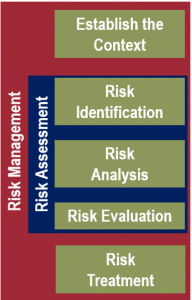With hurricanes, flooding and even typhoons wrestling for headlines on any given week, building resilience in a utility business today is more challenging than ever. The good news, though, is that understanding the challenges and risks your business faces every day is half the battle.
In order to build resilience, organizations have to identify risks and determine what threats each one poses. Awareness is the first step in building a robust resilience plan into any business. For example, utilities typically face additional pressure when developing Resilience Strategies while dealing with aging infrastructure, a changing workforce, diminishing margins, adverse events and funding shortages. Being prepared to deal with these five areas, specifically, can make all the difference in enduring and recovering quickly from a disaster.
Determining how prepared your business is for extreme events (planned or unplanned) will determine your organization’s resilience. Below are five areas your business can identify to build resilience and prepare for extreme weather.
1. Aging Infrastructure
Although most utilities face aging infrastructure, most failures are event-based and not directly related to the equipment’s age (up to 89 percent according to research that was done in the airline industry). Still, though, the age of equipment impacts its inherent reliability (resistance to failure).
Understanding the inherent reliability – a measure of overall “robustness” –of equipment or a system is the first step in building resilience into your company’s asset base. Critical assets must first be able to deliver their intended functions reliably throughout their useful life in order to survive events like storms, earthquakes and hurricanes. In order to be resilient, the asset must be in a good state of repair – meaning, the capability must exceed the user requirement with an adequate margin, and these margins depend on the strains placed on the assets.
2. Changing Workforce
A challenge faced by most organizations today, especially public sector and utilities, are the changing population demographics and retirement age. Workforce skills and expectations change regularly, making it hard to replace experienced workers. Because a well-trained and knowledgeable workforce is essential in every operation, understanding the impact of lost skills and knowledge is a crucial step in building workforce resilience. Organizations need an established process to retain experts’ knowledge and a system to manage that information effectively. An informed, experienced workforce can be essential to recovering quickly from a disaster.
3. Operating Context
The environment and environmental regulations impact utilities more than any other area of the business. Changing conditions and regulations, change in seasonal and daily demands, water supply shortages, storm events and adverse weather conditions can impact quality and service levels dramatically. These events can rarely be predicted or planned. This is why it is essential to build operational resilience into the systems (collection, treatment and distribution systems). In order to build operational resilience, organizations must understand what these environmental conditions are, how they can change and how they impact service levels and operations.
4. Planning and Finance
When funding is required for new capital projects, process improvements or asset refurbishments and replacements, there never seems to be enough at the right time. This means pressure to do more with less is a sentiment among every utility, including seeking funding at the local level. Because rate increases are sensitive matters, utilities have to optimize spending in order to maintain water quality, customer service and service levels while facing increasing demands and changing regulations. Proper planning and budgeting are key to building financial resilience. Understanding the Operating Context, future needs and demands, state of repair of the assets and the gap between canand wantis essential for achieving financial resilience.
5. Operations and Maintenance
Every piece of equipment, asset or system has at least one function (primary function) and in most cases, several functions (secondary functions). In order to preserve these functions, the equipment will require maintenance. It is important to understand what these functions are and what can cause them to fail in order to determine the correct maintenance. Ensuring safe and reliable operations are the responsibility of everyone involved in the process – engineers, operators and maintainers. Those closest to the equipment know the equipment best, and it is therefore important to involve the entire team in decisions to determine what the maintenance requirements should be.
Asset resilience can only be achieved with a proper understanding of the asset functions, asset capabilities and how these are preserved throughout their useful life. Operations have to operate the assets within safe operating windows and the right maintenance must be completed correctly.
In conclusion, in order to build resilience, organizations have to be aware of the risks associated with any disaster, including severe weather, and what threats they pose.
Risk is defined as follows:
Risk = Probability x Consequence
Probability must be put into the context of operations. What failures and events are probable, how often they would occur and what can be done to manage them. Consequence is the severity of the occurrence and how it matters, if at all.
Risk Management according to ISO 31000
- Establish the context (operating context)
- Identify the risk (functional failure or failed states)
- Determine (understand) the consequence of the failure and categorize the risk
- Determine the probability of the failure (likelihood of occurrence)
- Quantify the risk
- Identify risk management strategies to reduce or eliminate the risk (manage to a tolerable level)

Only a well-documented process that defines and records the state of repair (condition of the assets), operating and maintenance strategy for critical assets, the role of engineering, operations and maintenance in preserving the functions of the assets (throughout its useful life), skills and knowledge required to safely and reliably operate and maintain the assets and the financial resources needed to fulfill these requirements, will define what is needed to be resilient.
Aladon provides a suite of risk and reliability-based methodologies supported by world-class software, that has helped organizations globally for more than 30 years to identify the risks and best strategies for building resilience. Contact us for more information.

